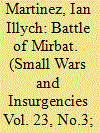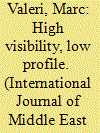| Srl | Item |
| 1 |
ID:
113214


|
|
|
|
|
| Publication |
2012.
|
| Summary/Abstract |
On 19 July 1972, the pivotal battle of the Dhofar rebellion occurred when over 250 communist guerillas, called adoos,1
attacked the coastal garrison town of Mirbat2 where nine men of the British 22nd Special Air Service Regiment were stationed. Their decisive defense of Mirbat led to decorations three years after the battle, the beginning of the end of the rebellion, and calls for the awarding of Britain's highest honor, the Victoria Cross. The Battle of Mirbat, let alone the Dhofar rebellion are little known outside the UK due3 to the covert nature of the SAS deployment, the then Labour government's obsession with secrecy, and the remoteness of the area of operations. Nonetheless, of all the proxy wars of the Cold War this one had the most significance, because had the communist adoos won, Oman and its Musandam Peninsula, which sticks out like a dagger into the Straits of Hormuz and abuts the United Arab Emirates, would have fallen into the communist orbit; threatening the West's oil supply. This is the story of the pivotal battle that was won by Britain and Oman against a communist insurgency.
|
|
|
|
|
|
|
|
|
|
|
|
|
|
|
|
| 2 |
ID:
095113


|
|
|
|
|
| Publication |
2010.
|
| Summary/Abstract |
If the U.S. invasion of Iraq in 2003 has produced unprecedented consequences for the internal policies of Middle Eastern regimes, this is not related to the upsurge of democratization that was supposed to spread like a contagion through the neighboring countries. Rather, it is due to the increased impact of the Shi?i issue on the national political agendas of many Arab states. Following the collapse of Saddam Hussein's regime, many observers thus drew attention to the emergence of what they regarded as a Shi?i "revival" in the Middle East-a perception that the military success of the Lebanese Hizbullah against Israel in the summer of 2006 seemed to confirm.
|
|
|
|
|
|
|
|
|
|
|
|
|
|
|
|